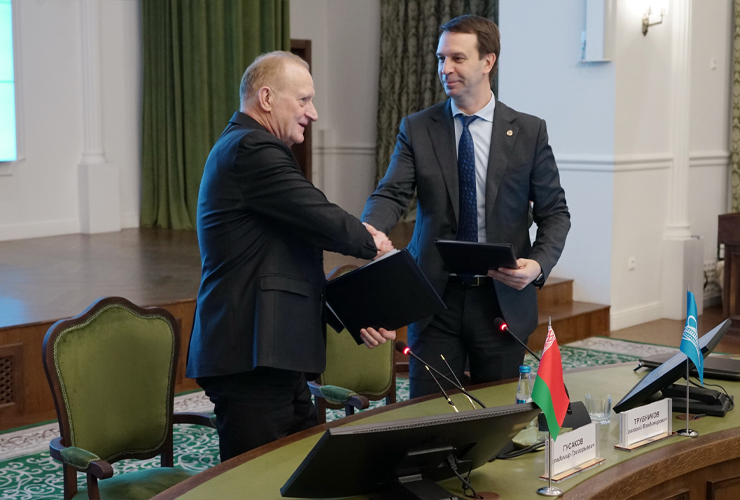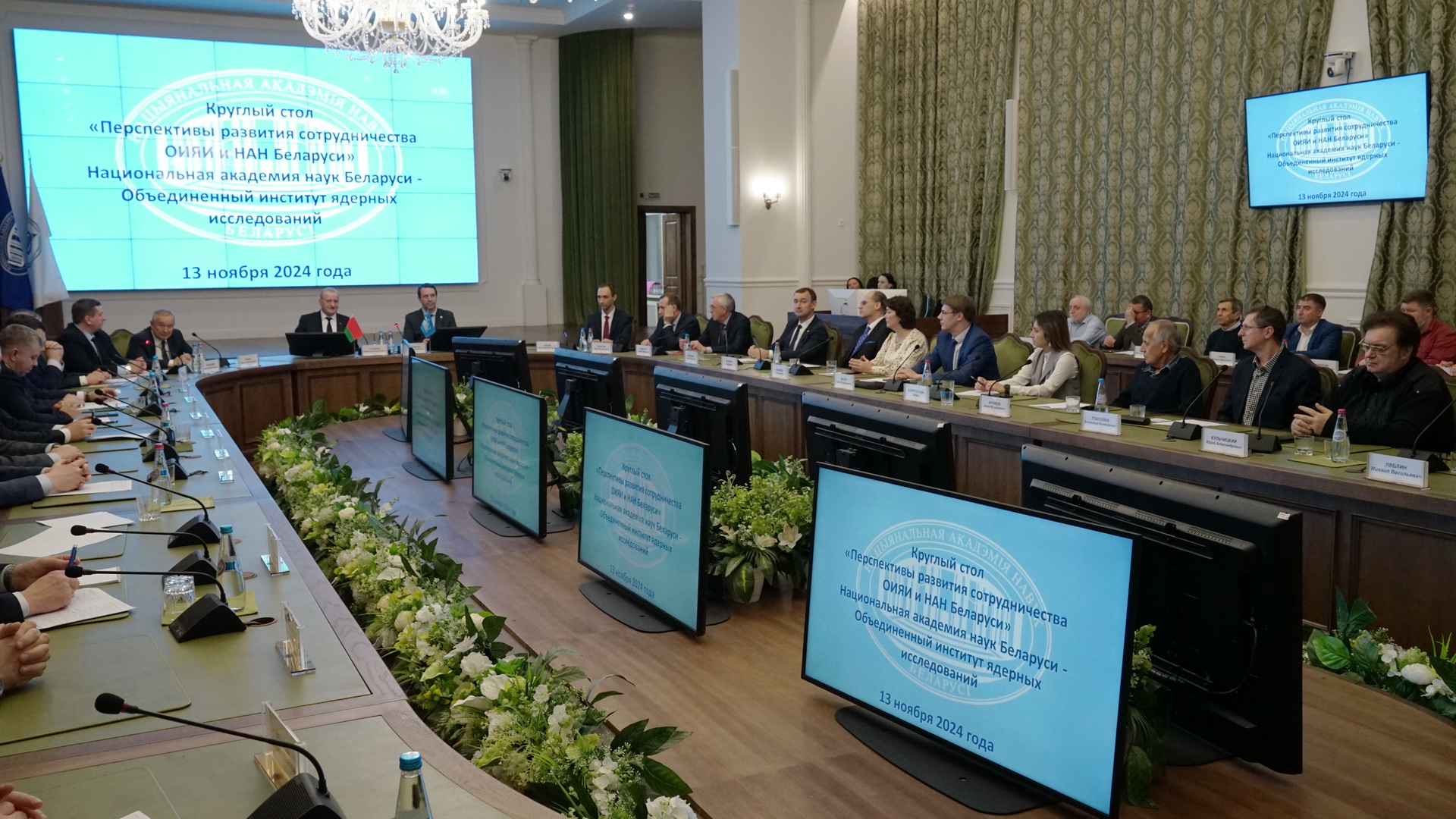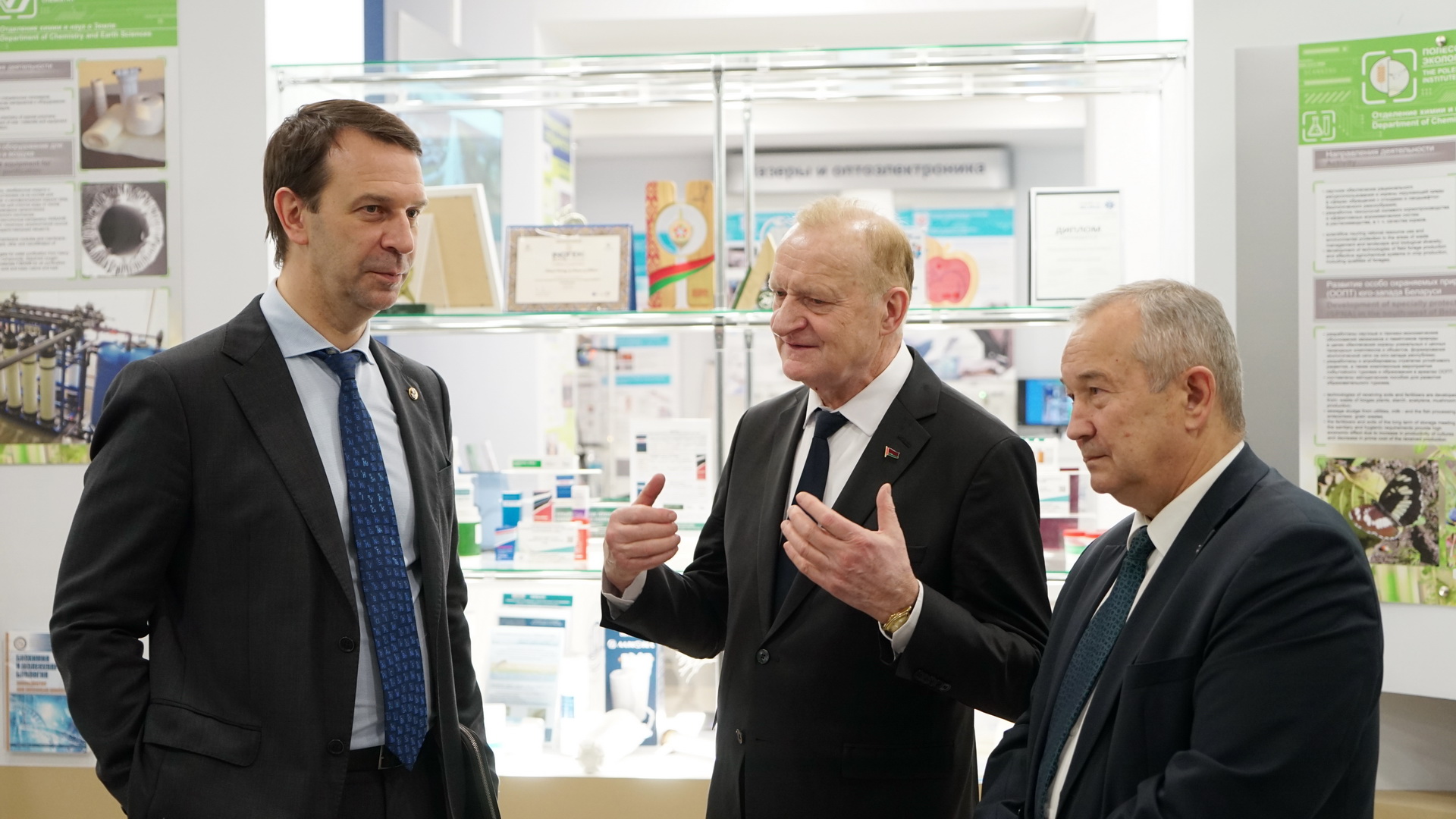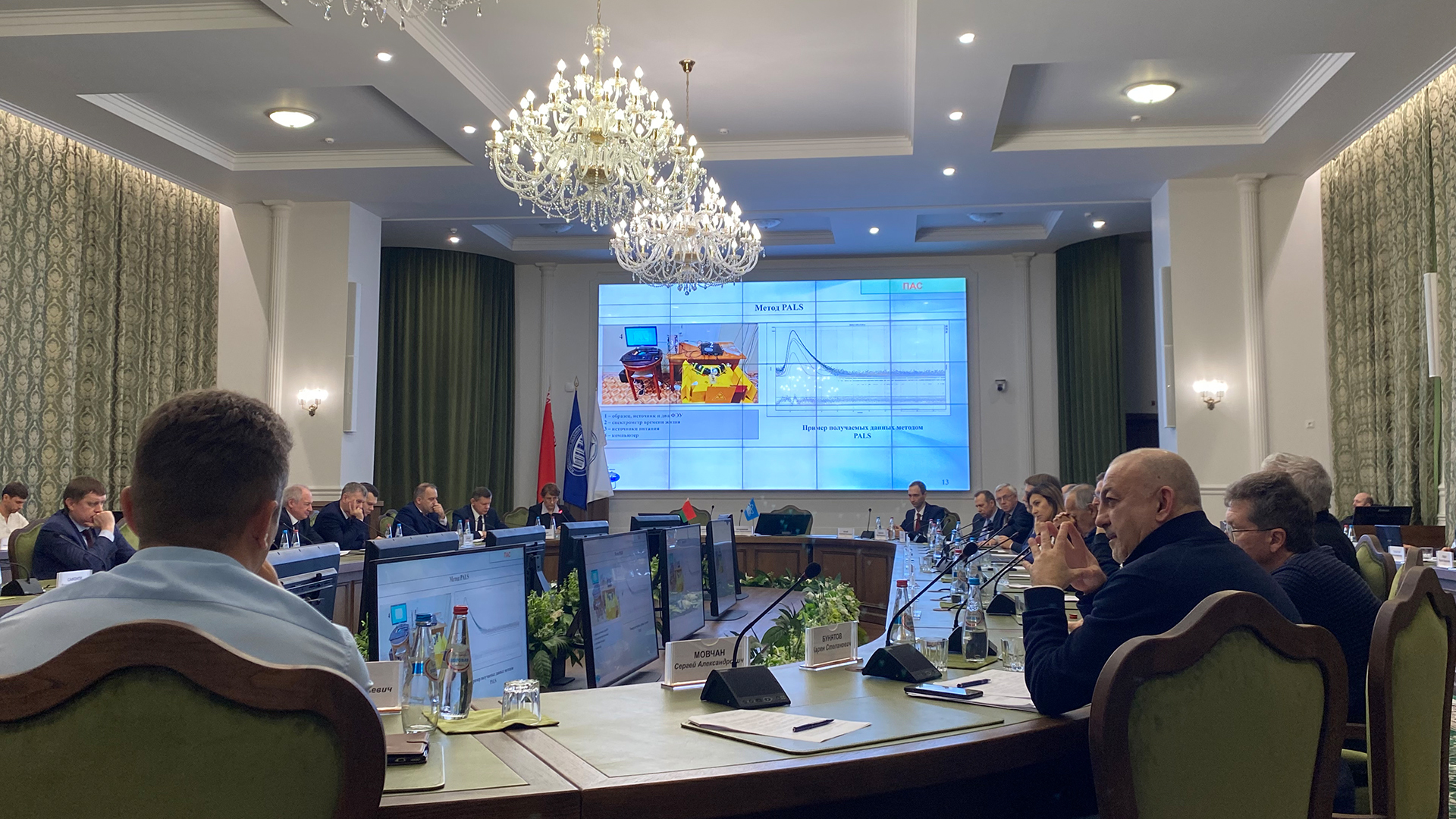Belarus Academy of Sciences and JINR discussed cooperation development prospects at round table in Minsk
News, 20 November 2024
From 10 to 15 November 2024, a Joint Institute delegation led by Director Grigory Trubnikov visited the National Academy of Sciences of Belarus (NASB) in Minsk. During a round table on 13 November, the parties discussed cooperation development prospects between JINR and the NAS of Belarus with the participation of the NASB leadership, heads of the Academy’s subordinate organizations, and JINR laboratories’ directors and leading specialists. Following the event, Grigory Trubnikov and NASB Presidium Chair Vladimir Gusakov signed a Letter of Intent to strengthen cooperation between Belarusian scientific centres and JINR in a number of areas of mutual interest.
NAS of Belarus Presidium Chair Vladimir Gusakov and Director of the Laboratory of Nuclear Reactions at JINR Sergey Sidorchuk delivered welcome speeches. “I hope that this round table will serve as a dynamic platform for not only exchanging experiences or discussing problems and new development trends in neutron and synchrotron research, but also coming up with constructive solutions to promote joint projects and include them in the JINR Topical Plan and the short-term JINR-NASB Cooperation Roadmap,” the Academy’s Presidium Chair concluded. Sergey Sidorchuk drew the attention to the long history of cooperation between JINR and Belarus, emphasising that the republic has been one of the most active Member States of the Joint Institute for many years. The FLNR Director expressed confidence that this partnership will continue to develop in the interests of both parties, taking into account the great potential for expanding cooperation, evident in the results of the JINR delegation’s visit to the NASB institutes.
During the round table, the JINR laboratories’ representatives made presentations on almost all areas of the Institute’s activities. FLNR Director Sergey Sidorchuk opened the first session of the round table by sharing information on the laboratory’s research into exotic nuclear systems with Belarusian colleagues. Director of the Laboratory of Radiation Biology at JINR Aleksander Bugay discussed fundamental and applied research in radiation biology and medicine at the JINR main facilities. The talk of the Director of the Laboratory of Neutron Physics at JINR Egor Lychagin was devoted to the experimental infrastructure of FLNP for users.
Head of the Sector for Detection Systems, Processing, and Analysis of Physical Information at the Laboratory of Nuclear Problems at JINR Yuri Kulchitsky spoke about experiments at the ring electron-positron collider. Head of the DLNP Scientific and Methodological Track Detector Group Vyacheslav Tereshchenko gave a presentation about the data collection system of the SPD Detector at NICA. An overview of the research conducted at the Baikal-GVD Neutrino Telescope was provided by the facility’s Head Igor Belolaptikov. A senior researcher at the Laboratory of Information Technologies at JINR Danila Oleynik discussed the issue of organizing data processing in the SPD Experiment.
Head of the Linear Accelerator Sector at the Laboratory of High Energy Physics at JINR Valery Kobets started the second session of the round table with a presentation about a new DLNP JINR facility, LINAC-200. Head of the DLNP Laser Metrology Sector Mikhail Lyablin told the NASB colleagues about the small precision laser inclinometer and seismic event registration at the Naroch Geophysical Observatory. The development of a matrix semiconductor X-ray detector that can register register single photons and estimate their energy was the topic of Vyacheslav Tereshchenko’s second talk. A DLNP researcher Semyon Gursky spoke about the cyclotron for medical applications. A DLNP JINR engineer Alexey Sidorin discussed positron annihilation spectroscopy. A DLNP engineer Alexander Dyatlov spoke about a source of Gaussian and Laguerre-Gaussian relativistic electrons based on a photoinjector setup. The second session of the round table concluded with a talk by Deputy Head of the VBLHEP JINR Department of Scientific and Methodological Research and Innovation Oleg Belov on applied research using heavy ion beams of the NICA Complex.
Following the round table and the visits to the organizations of the National Academy of Sciences of Belarus, NASB Presidium Chair Vladimir Gusakov and JINR Director Grigory Trubnikov held talks. They discussed joint research between the organizations and identified possible steps to strengthen cooperation in fundamental and applied science for the socio-economic development of the Republic of Belarus and other JINR Member States.
Vladimir Gusakov noted that JINR plays a special role among all the Academy’s partner organizations residing in the Russian Federation. The NASB Presidium Chair stressed that the Joint Institute is engaged in the world’s most advanced science, thanks to which NASB–JINR cooperation helps improve research in the republic. The Joint Institute’s Director drew attention to the fact that the main result and prospect of JINR–Belarus research is the invaluable experience gained over decades of cooperation, the experience of collaborative efforts of JINR Member States to create the largest unique facilities not only in Dubna, but also in Belarus, CERN, the USA, and China. Grigory Trubnikov noted that the JINR delegation included not only representatives of various Member States of the Joint Institute (Kazakhstan, Romania, the Russian Federation, Slovakia, Uzbekistan), but also representatives of several generations of scientists who serve as an example that demonstrates the important role of the fundamental approach to research and the concept of scientific school in JINR’s activities.
The Director of the Joint Institute thanked the NASB for their consistent hospitality and stressed that the visit to Minsk had opened up new prospects for JINR’s partnership with the Academy, particularly in information technology, life sciences and biotechnology, ecology and materials science, and the engineering of new-generation batteries. In addition, Grigory Trubnikov drew the attention of the audience to areas in which cooperation is already actively developing, including laser physics, optics, theoretical physics, and fundamental mathematics.
Following the talks, representatives of the Joint Institute and the NAS of Belarus expressed their intention to strengthen partnership between Belarusian scientific centres and JINR. In addition, they agreed to further work on promoting the existing joint research areas and identifying new ones, a number of which were fixed in the Protocol signed as a result of the round table.
During the visits to the organizations of the NAS of Belarus, the JINR delegation was represented by the directors of three laboratories: Sergey Sidorchuk (FLNR), Egor Lychagin (FLNP), and Aleksander Bugay (LRB), along with MLIT Deputy Director Nikolay Voytishin, FLNP Deputy Director Norbert Kucerka, Deputy Head of the VBLHEP Department of Scientific and Methodological Research and Innovation Oleg Belov, DLNP Assistant Director for International Cooperation, Innovation and Education Programmes Ayagoz Baimukhanova, and about 20 leading specialists from four JINR laboratories.
The JINR delegation visited the NASB Physical-Technical Institute, NASB Luikov Heat and Mass Transfer Institute, NASB Scientific and Practical Centre for Materials Science, NASB Institute of Applied Physics, NASB Stepanov Institute of Physics, State Scientific and Production Association of Optics, Optoelectronics, and Laser Technology, NASB Joint Institute of Mechanical Engineering, Minsk Research Institute of Radiomaterials, NASB Joint Institute for Power and Nuclear Research – Sosny, NASB United Institute of Informatics Problems, NASB Institute of Mathematics, and NASB Institute of Energy. Representatives of the NASB institutes’ directorate told the JINR delegation about the history and main directions of their research and development activities, and the parties held cooperation negotiations.




